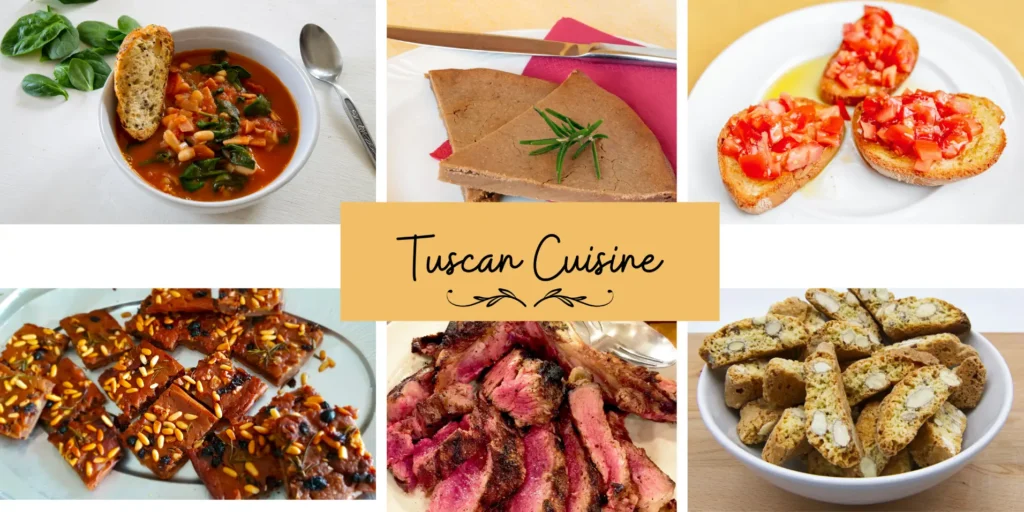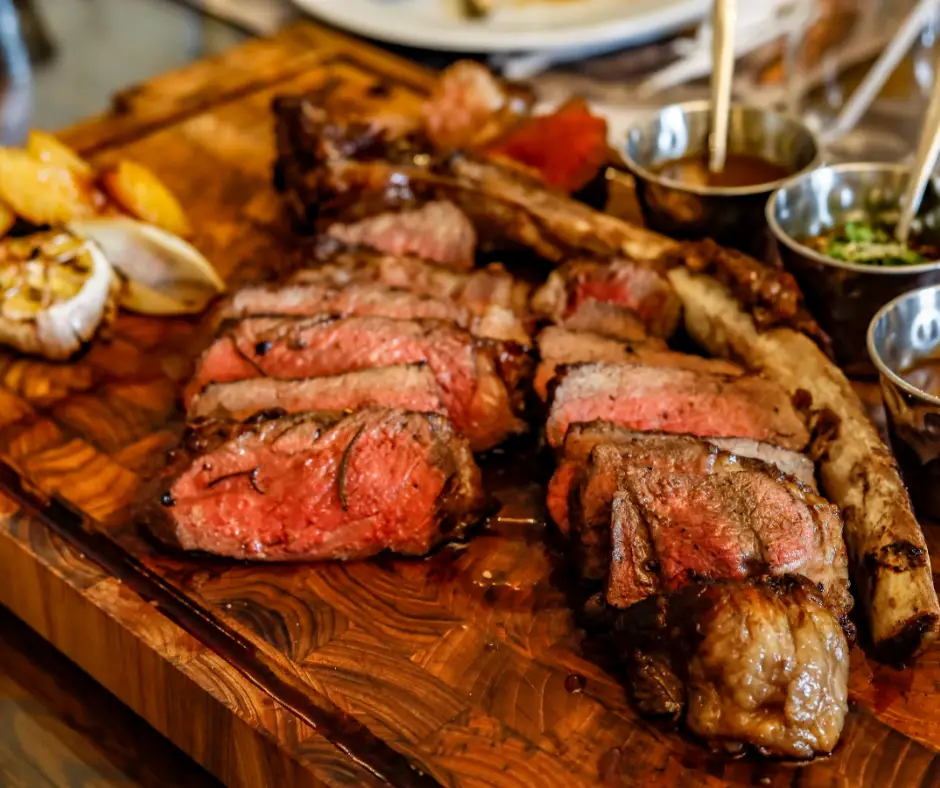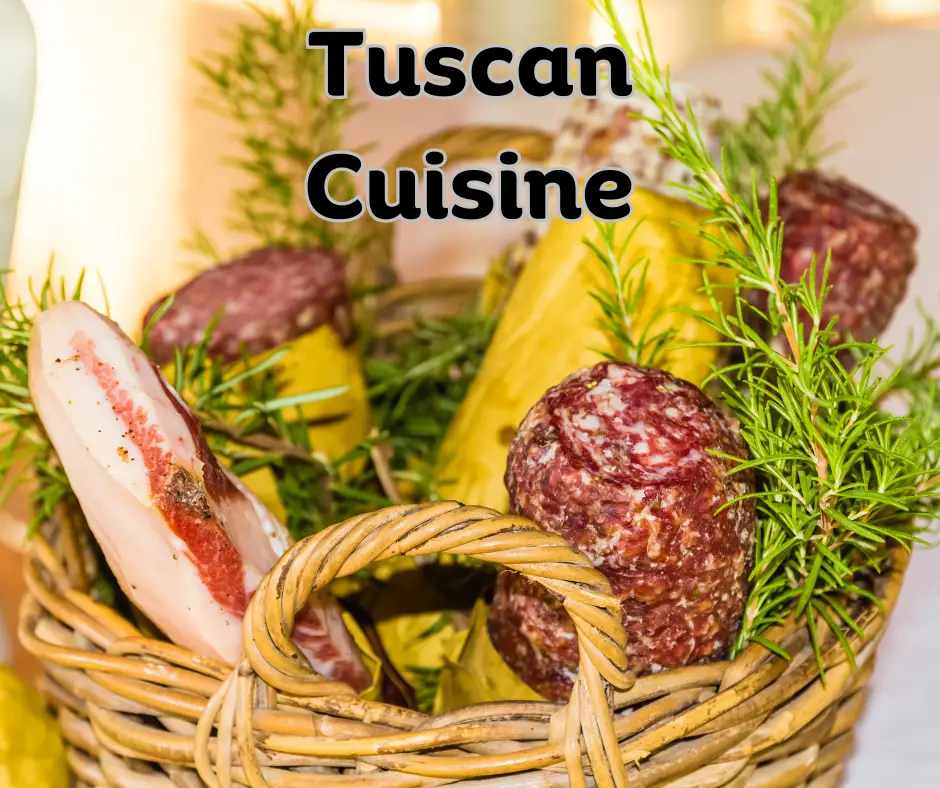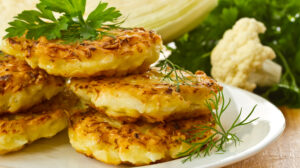Tuscan Food: 10 Iconic Dishes and Popular Sweets
Disclosure: This page contains affiliate links. If you make a purchase through these links, I may earn a small commission to help me support my blog.📝
The cuisine of Tuscany demonstrates that simplicity doesn’t equate to monotony. As prosperity spread through the region over the last half-century, Tuscans tenaciously held onto their culinary tradition. Tuscan food reflects the emphasis on natural flavors, quality ingredients, and simple recipes has left a culinary legacy far beyond the kitchen. On special occasions, Tuscan chefs create more elaborate dishes to honor the region’s diverse cultural and culinary history.

Credit: Canva
Tuscan cuisine’s hallmark lies not solely in its dishes. The region is widely recognized for producing some of the world’s finest wines and extra virgin olive oil. Thanks to the dedication of their residents, these products have achieved global acclaim. Tuscan cuisine stems from its varied landscape ranging from seashore to valleys, hills and mountains. This geographical diversity infuses dishes from this region with an array of flavor profiles ranging from succulent meats and exotic beans, and wild game to succulent seafood dishes. Tuscany stands out among the Italian regions for having 456 traditional food products officially registered as Protected Designation of Origin (PDO) or Protected Geographical Indication (PGI), an outstanding achievement demonstrating their dedication to protecting and promoting Tuscany’s culinary treasures..
Pasta, Soup, and Steak: The Staples of Tuscan Cuisine
Let’s take a look at some signature dishes from Tuscany. I’m sure you have heard and maybe already tasted some of them.
The renowned Pappardelle al Cinghiale, for example, you can easily find on most Tuscan restaurant menus. Pappardelle al Chinghiale features wide ribbons of pasta topped with wild boar meat sauce. This dish demonstrates both fresh local ingredients as well as Tuscany’s hunting traditions. Ribollita, a delicious Tuscan soup featuring beans, vegetables, and stale bread as the primary ingredients, originated as part of Tuscan peasant culture to use up any leftover ingredients while providing a filling meal using simple yet affordable ingredients. Tuscany is famous for its beef production and preparation, especially La
Bistecca alla Fiorentina is a thick-cut steak grilled over charcoal with salt, pepper and olive oil for optimal results. This dish stands as an emblematic representation of Tuscan pride and excellence in meat production and preparation.

Credit: Canva
More Delights from the Tuscan Kitchen
Tuscany boasts a rich culinary heritage with a variety of specialties beyond Pappardelle al Cinghiale, Ribollita, and Fiorentina Steak. Here are some more Tuscan dishes you might want to try:
- Crostini Toscani: Toasty bread slices covered with an aromatic chicken liver pate are the epitome of Tuscan cuisine and serve as an unforgettable appetizer.
- Fettunta vs Crostini: Two delicious Tuscan appetizers are both types of toasted bread appetizers known as Fettunta and Crostini, though each differ in some way. Fettunta is a simple dish consisting of grilled bread rubbed with garlic and drizzled with extra virgin olive oil, usually seasoned with salt and sometimes rosemary. Traditionally enjoyed in November to test the new oil production from Tuscany. Crostini, on the other hand, are typically smaller and thinner baguette slices, which are then toasted before topping with various ingredients such as chicken liver pate or cheese, as well as vegetables pates.
- Pappa al Pomodoro: Pappa al Pomodoro is a hearty bread and tomato soup with garlic, basil and olive oil for added flavor and rustic charm. First made famous by Il Giornalino di Gian Burrasca children’s book published in 1911;. Later through a TV adaptation in 1964, featuring singer Rita Pavone performing her catchy rendition of Viva la Pappa col Pomodoro! Pappa al Pomodoro perfectly represents the Tuscan concept of cucina povera (or poor cuisine), where simple ingredients, often leftover from other dishes, can come together in creative, delicious and satisfying meals.
- Caciucco: This is a fish stew that traditionally was made by fisherman in Livorno to use up any leftover unsold smaller fish. Today, Cacciucco is an exquisite Tuscan coast treat. Inspired by Arabic word kükük, which means small, it describes the kind of fish typically used in Cacciucco stew. Nowadays, the dish includes all sizes of fishes. It’s a bit expensive, and restaurants tend to offer it only for large groups or if they a lot of daily customers! I tried to order it once, but I was told that they would only prepare it for a party of 10 or more.
- Farinata: Farinata is a chickpea flatbread that’s both crispy on the outside and soft inside, making it a popular street food choice and gluten-free alternative.
- Acquacotta (which translates to “cooked water”) is a delicious vegetable soup often enhanced with poached eggs that is representative of Maremma, once an isolated and impoverished region, yet rich with natural resources and biodiversity. Acquacotta serves to showcase some of its staple products – tomatoes, onions, fennel, celery, kale, beans, cheese and eggs that define the Maremma cuisine.
- Cinghiale in Umido: Slow-cooked wild boar stew, showcases Tuscany’s love for game meats. Chinghiale has a dark color, a lean texture, and a rich, slightly sweet, and earthy flavor. It’s a robust and savory dish served with a side of polenta or mashed potatoes or paired with tagliatelle.
- Crespelle alla Fiorentina: Crepes filled with ricotta and spinach, baked in a bechamel sauce. It’s a delightful dish that combines the creamy richness of the filling with the subtle flavors of spinach.
- Schiacciata: A type of flatbread similar to focaccia, often topped with olive oil, salt, and rosemary. It’s a versatile bread enjoyed as a snack or accompaniment to meals. Caution: If you have a low-sodium diet or are prone to acid reflux, you may want to limit your intake of this delicious bread as it tends to be salty.
- Trippa: Florentine tripe, or trippa alla fiorentina, is a traditional dish from Tuscany that consists of strips of tripe cooked with tomatoes, onions, carrots, celery, garlic, herbs, and olive oil. It is usually served with grated Parmesan cheese and crusty bread. Tripe is the edible lining of the cow’s stomach, and it has a mild taste and a tender texture when cooked properly. Florentine tripe is a street food staple in Florence, along with lampredotto, which is another type of tripe from the cow’s fourth stomach. Florentine tripe is a dish that showcases the region’s culinary history and passion for quality ingredients. If you are grossed out by the idea of eating tripe, be brave and give it a try. It tastes delicious, and it’s good for your gut. After all, you are what you eat. 😜
Exploring these Tuscan specialties will provide you with a well-rounded taste of the region’s culinary diversity and Tuscan history. Each dish reflects the simplicity, quality, and passion that define Tuscan cooking.
Wine: The Perfect Companion for Tuscan Dishes
No Tuscan meal would be complete without wine, and Tuscany boasts some of the world’s finest. Chianti Classico stands out as an iconic example. Made from Sangiovese grapes grown between Florence and Siena on hilly terrain, its deep color, fruity aroma, and full-bodied flavor make it perfect to pair with pasta, meat, and cheese dishes alike. Vin Santo is another classic Tuscan wine, serving as a sweet dessert wine made from dried grapes. It boasts golden hues, honeyed aromas, and nutty notes that pair beautifully with cantucci biscuits dipped into this dessert wine before being enjoyed as part of a Tuscan feast. This combination provides the perfect end to any feast.
To learn more about Tuscan wines, check this article on the best Tuscan wines in 2024 that won prestigious awards both in Italy and worldwide.
Sweet Temptations: Exploring the World of Tuscan Desserts
Tuscan desserts are an absolute must for visitors of the region. Renowned for their simple yet exquisite use of almonds, honey and spices to showcase Tuscany’s commitment to quality and traditional flavors, these desserts also have long been tied with celebrations and festivals – perfect for commemorative moments!
Tuscan desserts have quickly gained international acclaim and can now be found everywhere from artisanal bakeries and Italian restaurants around the globe. Check my Recipe section where I collect recipes from all over Tuscany.
Each sweet treat serves to illustrate Tuscan history and culture. When visiting Tuscany, make sure to try each dessert for an immersive culinary experience that highlights local flavors, as well as its vast culinary legacy.
In full disclosure, these sweets are an acquired taste. I, for one, may like some more than others and find other regions in Italy have more delectable cookies and sweets. But that’s my biased opinion. I invite you to try these sweets and then judge for yourself:
Panforte: Panforte is a dense fruitcake made with nuts, honey, and spices for an energy-packed and tasty treat that has been enjoyed for centuries. This is one of my least favorites. Too sticky and sweet. You should give it a try.
Ricciarelli: These almond-flavored cookies feature a chewy interior with an irresistibly sweet, powdered sugar topping – providing the perfect balance of sweetness and nuttiness! I like these a lot.
Tiramisu: While Tiramisu can be found throughout Italy, every region puts their own special touch to this popular dessert. In Tuscany for instance, you might come across versions that incorporate local ingredients. There is no bad version of Tiramisu!
Zuccotto: Zuccotto is a chilled dessert resembling a dome-shaped cake, typically filled with layers of sponge cake, chocolate and ricotta cream for an enjoyable treat during warmer weather. I confess I only tried the Sicilian version.
Cavallucci are small diamond-shaped cookies made with honey, almonds, and candied fruits – each offering its own distinct yet slightly spicy taste profile.
Biscotti di Prato: These almond biscuits, similar to Cantucci, can be enjoyed with your latte in the morning, or dipping them in Vin Santo, a regional sweet wine.
Castagnaccio: An earthy chestnut flour cake featuring pine nuts, rosemary, and sometimes raisins as ingredients. This is an acquired taste….
Conclusion
Tuscan food has made an indelible mark around the globe. From the hearty ribollita and delicate pappa al pomodoro dishes to pappardelle al cinghiale or Florentine steak—each one reflects the simple ingredients, passion, and tradition that characterize the cuisine of Tuscany.
I also mentioned that Tuscany is famous for more than just its food; its wines are equally legendary. They serve as the ideal companions to pasta, meat, and cheese dishes alike. Don’t miss the article about the top Tuscan wines in 2024, which have received global acclaim as evidence of Tuscany’s commitment to excellence. And speaking of wines, don’t overlook Vin Santo—an enticing dessert wine with golden hues and subtle nutty notes—perfect for pairing with cantucci biscuits during an authentic Tuscan feast!
Each dish tells a unique tale about Tuscan history and culture. Taste is subjective, so some sweets may resonate more than others, and opinions vary widely. That is part of the beauty of Tuscan cuisine—it encourages exploration, sampling, and ultimately developing one’s own opinions about each dish served up to you. Dear reader, I invite you to try these culinary delights and create your own Tuscan memories.





